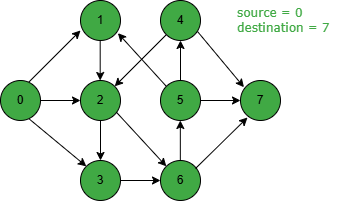
 Data Structure
Data Structure Networking
Networking RDBMS
RDBMS Operating System
Operating System Java
Java MS Excel
MS Excel iOS
iOS HTML
HTML CSS
CSS Android
Android Python
Python C Programming
C Programming C++
C++ C#
C# MongoDB
MongoDB MySQL
MySQL Javascript
Javascript PHP
PHP
- Selected Reading
- UPSC IAS Exams Notes
- Developer's Best Practices
- Questions and Answers
- Effective Resume Writing
- HR Interview Questions
- Computer Glossary
- Who is Who
C++ Program to Find Maximum Number of Edge Disjoint Paths
According to the problem statement, we have a directed graph and two vertices that are source s and destination/target t. Our task is to determine the maximum number of edge-disjoint paths that can be found from vertex s to vertex t. If two paths do not share any edge, then it is known as an edge-disjoint.
A directed graph is a digraph where edges have a specific direction. They point from one vertex to another.

There can be a maximum two-edge disjoint path from source 0 to destination 7 in the above graph. The two edge-disjoint points highlighted below in red and blue colors are 0-1-2-6-7 and 0-3-6-5-7.

It's important to note that paths may be different but the maximum number is the same. For example, in the above diagram possible set of paths is 0-2-6-7 and 0-3-6-5-7.
C++ Program to Find Maximum Number of Edge Disjoint Paths
In the following C++ example, we create a program to find a maximum number of edge-disjoint paths:
#include <iostream>
#include <climits>
#include <cstring>
#include <queue>
#define n 7
using namespace std;
// Function to check if there is a path from source 's' to target 't'
bool bfs(int g[n][n], int s, int t, int par[]) {
bool visit[n];
// Mark all nodes as unvisited initially
memset(visit, 0, sizeof(visit));
queue < int > q;
q.push(s);
visit[s] = true;
// Source has no parent
par[s] = -1;
while (!q.empty()) {
int u = q.front();
q.pop();
// Check adjacent nodes of 'u'
for (int v = 0; v < n; v++) {
// If the node is unvisited and has a positive edge capacity
if (visit[v] == false && g[u][v] > 0) {
q.push(v);
// Store parent node
par[v] = u;
visit[v] = true;
}
}
}
// If destination is reached, return true
return (visit[t] == true);
}
// Function to find the maximum number of edge-disjoint paths from 's' to 't'
int findDisPath(int G[n][n], int s, int t) {
int u, v;
int g[n][n];
// Create a copy of the original graph
for (u = 0; u < n; u++) {
for (v = 0; v < n; v++)
g[u][v] = G[u][v];
}
// Array to store the path
int par[n];
int max_flow = 0;
while (bfs(g, s, t, par)) {
int path_flow = INT_MAX;
// Find minimum capacity along the path found by BFS
for (v = t; v != s; v = par[v]) {
u = par[v];
path_flow = min(path_flow, g[u][v]);
}
// Update residual capacities along the path
for (v = t; v != s; v = par[v]) {
u = par[v];
g[u][v] -= path_flow;
g[v][u] += path_flow;
}
max_flow += path_flow;
}
return max_flow;
}
int main() {
int g[n][n] = {
{0, 6, 7, 1},
{0, 0, 4, 2},
{0, 5, 0, 0},
{0, 0, 19, 12},
{0, 0, 0, 17},
{0, 0, 0, 0}
};
// Define source and destination nodes
int s = 0, d = 3;
cout << "There exist maximum " << findDisPath(g, s, d) <<
" edge-disjoint paths from " << s << " to " << d;
return 0;
}
Following is the output of the above code:
There exist maximum 3 edge-disjoint paths from 0 to 3

